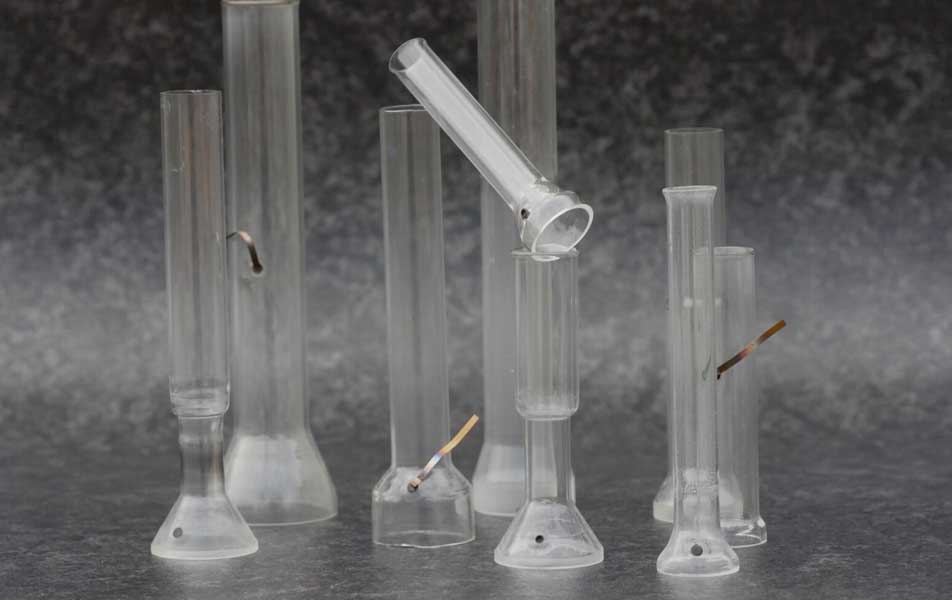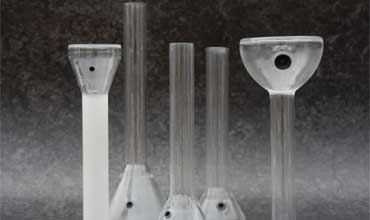The cathode ray tube is an item that many people would not know the use of if confronted with the name alone.
While a cathode ray tube (CRT) is a fairly unknown thing, many of us have them in our homes, workplaces, and in the many different places we visit every day.
One of the most common examples of this is in TV sets. 95% of UK homes have a TV set, and most of these will contain one of these tubes.
One of the key components of the CRT is the glass envelope of which all of the smaller parts are stored, including the electron gun and the phosphor-coated screen.
Here at Moore’s Glassworks, we are custom glass manufacturers who specialises in certain items, such as CRTs.
Throughout our blog, we like to give you insights into just what goes on in our manufacturing plant, and that’s why we’ve created this guide on how we create cathode ray tube glass.
Let’s take a look.
The Requirements of Cathode Ray Tube Glass
In order for a CRT to function properly, there are several requirements that the glass envelope we manufacture must adhere to.
These include:
- Transparency – The way a cathode ray tube works is that electrons pass through it to strike the phosphor-coated screen. Any impurities in the transparency of the glass, such as marks or blemishes, can interfere with the electron transmission and make it unable to work as it should. This is why ensuring the glass is completely transparent is so vital.
- Thermal Stability – The inside of a cathode ray tube can exceed 1000 degrees Celsius. If the glass is not made to withstand this much pressure, it could crack, so we must ensure every CRT envelope is tough against heat and able to deal with the rigours of thermal expansion without it leading to any damage.
- Smooth – A CRT is used to display images on electronic devices, so to make sure the image being shown is clear and without any blurring, you must have a smooth glass. If there are any bumps or chips then the image may be distorted.
- Strength – When it comes to manufacturing, exporting, and using a CRT, there are a lot of pressures that the item is put under. You must make sure your glass is of the right consistency and strength to be durable against all of these processes without wilting or cracking or else you may find the need for a replacement within a short time of it’s manufacture.
- Thickness – When it comes to the thickness of the glass envelope, consistency is key. If you have different levels of thickness throughout your envelope, then this will cause the image to distort. Also, having glass that is too thick can cause the image to blur and not be as sharp and clear as needed.
There are many features CRT glass must have, and these are just a select few.
This is why it is always a good choice to work with a team that specialises in creating such items if you are looking to have some manufactured.

Cathode Ray Tubes
The Cathode Ray Tube Glass Manufacturing Process
Step 1: Create the Glass
As with all glass products, the process of forming and melting the glass is the first one.
Whether with pre-mixed materials, glass you simply have to melt down, or working from scratch combining raw materials such as silica sand, soda, ash, and limestone, you must begin by getting a concoction ready to be molded.
Once you have your mixture and it has been heated (often to temperatures well above 1000 degrees) pour the glass onto a flat surface where it can be cooled and annealed to remove any residual stresses.
Step 2: Get the Right Size
Now you must separate your glass so that you have just the right size that you need to get to work.
This depends solely on the item you are making, and one of the benefits of working with a custom glass manufacturer is that they can create items in a wide range of sizes, listening to you and your needs first.
Once you have the glass you need, it must be checked for any bubbles or cracks as well as the uneven thickness mentioned earlier.
This is a crucial time and any sheets that are showing defects should not be used as it may affect the final product.
It is also a good idea to give the glass a clean and polish to ensure the surface is as smooth as possible.
Step 3: Form the Shape
Now your CRT can begin to come to life.
Through a process called drawing, the glass is heated until soft and then stretched and pulled until it resembles a long, narrow tube.
This will be the main shape of your CRT, so it is vital that you stick closely to the required measurements.
Once you have the tube at your desired length, it can be cut and the ends can be heated and polished whilst under heat to make sure all edges are smooth and there are no sharp bits that could cause injury.
Step 4: Seal the Tube
At this point, the tube is still open at both ends.
The next step is to seal one end of the tube with a stem, which will serve as the point of attachment for the electron gun. The stem is made of a different type of glass that has a lower melting point than the main glass envelope. The stem is heated and fused to the end of the tube, creating an airtight seal.
While at Moore’s Glassworks, we manufacture the casings, if you wanted to complete the full CRT, then follow the steps below.
The other end of the tube is left open, and the inside of the tube is coated with a layer of phosphors. The phosphors emit light when struck by electrons, creating the image on the screen. The phosphor coating is applied using a process called vacuum deposition, in which a layer of phosphor material is evaporated in a vacuum chamber and allowed to settle onto the inside of the tube.
Finally, the electron gun is inserted into the stem at the sealed end of the tube. The electron gun emits a beam of electrons, which are focused and directed onto the phosphor-coated screen by magnetic fields. When the electrons strike the phosphors, they emit light, creating the image on the screen.
Cathode Ray Tube Manufacture with Moore’s Glassworks
The manufacture of CRT glass is a complex process that requires lots of precision and attention to detail.
If you’re looking for custom manufacturing of cathode ray tube glass then why not get in touch with Moore’s Glassworks.
We have years of experience creating these items, and know just how to make envelopes that are fully functional and always high quality.
Want to know more? Then contact our team today.
Or why not check out our previous blogs on the many uses and the story of cathode ray tubes?


Leave a Reply